With a bullet to the head from Samsung, 3D TV is now deader than ever
It may shamble forward zombie-style for a few more years, but without the world's No. 1 TV maker on board, 3D TV is doomed.

If you're among the few who actually don 3D glasses to watch movies at home, you're not gonna like this. If you're everyone else, you probably couldn't care less.
3D, once hailed as a breakthrough new feature on TVs and propelled into mainstream consciousness by the blue aliens of "Avatar" and the efforts of ESPN and DirecTV, has been waning in popularity for years. Now it has absorbed that most telling of deathblows from the biggest gun in the TV hardware business.
A source at Samsung, who asked to remain anonymous, has confirmed to CNET that none of its 2016 US TV models will support 3D.
That means they won't be able to display 3D Blu-ray movies or other 3D content and won't work with 3D glasses. The only Samsung sets that will support 3D will be carryovers from 2015, like the UNJU7100 series.
The reason, according to the source, is that Samsung wanted to concentrate more resources on its new smart TV functionality, including integration with its SmartThings home automation platform.
In other words, Samsung traded 3D for braaains.
This confirmation for the US market comes on the heels of previous reports from Europe and Korea that 3D would play no part in Samsung's future TV plans.
Samsung is the biggest TV maker in the world and has tremendous influence, marketing features like LED backlights for LCD TV panels and curved screens that other makers scramble to emulate. Until this year all of its best TVs, and many midrange models, supported 3D. Now even its most expensive 2016 sets will be 2D-only.
According to data from the NPD Group, 3D TVs have accounted for a diminishing share of US flat-panel TV sales every year since 2012, and the same goes for 3D-compatible Blu-ray players compared with 2D-only models. 3D TVs fell from 23 percent to 16 percent in that period, and 3D players from 40 percent to 25 percent.
"In terms of purchase motivators, I think 3D is pretty low on the list at this point," said NPD analyst Ben Arnold. "There was a lot of interest in the feature from consumers early on, but most reports were the experience was not worth the hassle of wearing 3D glasses or finding content."
LG's 65EF9500 OLED TV delivered the best 3D we've ever tested. Its successor will be 2D-only.
With other TV brands, cost of 3D goes up
LG, the No. 2 TV maker worldwide, is actually holding steady. Tim Alessi, director of new product development, told CNET that 3D "still remains a meaningful step-up feature for many" consumers. About a third of the 2016 series TVs it will sell in the US support the feature. On the other hand, all of them will be high-end 4K OLED and LED LCD models.
Case in point: LG's main series of flat 4K OLED for 2016, the B6, won't support 3D. That's a shame for any remaining 3D fans because its 2015 predecessor, the EF9500 series, delivered the best 3D image quality we've ever tested.
Then there's Vizio. A major brand in the US but not worldwide, Vizio hasn't offered 3D on any of its TVs since 2013; even the exceedingly expensive Reference Series is 2D-only. And Sony's rep told CNET that only two of its US series, the X930D and X940D, will support 3D in 2016. The cheapest costs $3,200.
The fate of the third dimension
3D movies continue to be released in theaters, and 3D Blu-ray discs will likely be sold for a few more years, so owners of current 3D TVs still have some use for those glasses. Streaming services like Netflix, Amazon and Vudu still offer a few titles too, but they can be difficult to find, and the new 4K Blu-ray disc format contains no provisions for 3D support at all.
And all those fancy new VR headsets, like the Oculus Rift, HTC Vive, and Samsung Gear VR? They're basically supercharged 3D displays that are glued to your face.
But if you want a new 3D TV in 2016, your choices will be much less expansive -- and more expensive -- than before.
So no, just because Samsung dropped support, 3D TV isn't technically dead yet. But it's closer to the grave than ever.

